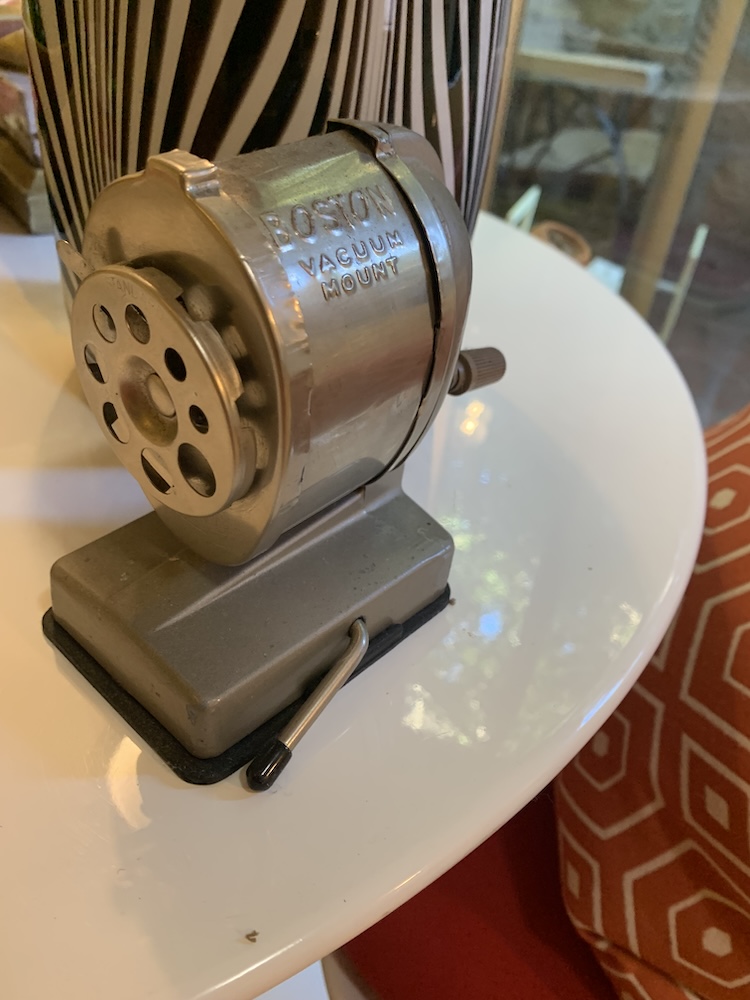Boston Vacuum Mount Pencil Sharpener

Few illustrious tourist attractions in Ohio rank higher than the Reverend Paul Johnson’s Pencil Sharpener Museum located in the middle of the State, a menagerie donated by the Reverend’s wife after he collected approximately 4,000 sharpeners from 1989-2010. He left her holding the collection when he died in 2010. She had no one to blame but herself as she bought him his first sharpener.
The Good Reverend collected pencil-sharpening Garfields, Mickeys, Tweety Birds, tractors, airplanes, trains, and U.S. presidents who sharpened with their mouths, as well as panda bear sharpeners, which sharpened pencils from the other end. The displays are grouped in relationship to his themes; you can visit food-themed sharpeners, music-themed, or travel-themed. My attention turned to the historically-themed sharpeners. In my past our family had a Boston Vacuum Mount Vintage Pencil Sharpener, circa 1950s, which belonged to my mom. I have it now in my kitchen to remind me of the sound of Mom’s hand cranking as she sharpened pencils for my daily math lesson.
How I dreaded that sound. Mom is a musical and math genius, and I had no talent for numbers and had youthful problems learning to count. So, the Boston sharpener, and what it represented, was not my friend.
The pencil sharpener, given its due, ranks among the finest tools of the world. Mom’s Boston Vacuum mounted sharpener had an adjustable hole size and a twist off canister, and was made in her home state of New Jersey – Camden to be precise. When in 1957 the company moved to North Carolina it was purchased by X-ACTO, which was in turn absorbed by Elmer’s Glue.
The pencil itself was invented under Napoleon’s watch by one of his army officers, a French scientist Nicolas-Jacques Conté in 1795. Back in Concord, MA, in 1812 William Monroe made America’s first pencil, and another Concord native, Henry David Thoreau, the famous philosopher and author, made his own improved design. Before the invention of the pencil, folks used graphite, but it was messy.
Aside from our family’s Boston sharpener, there exists a more “expensive” 1950s Boston Vacuum Mount Pencil sharpener which has a spring-loaded grip at the front of the different sized holes to hold the pencil while it is being sharpened, and the very advanced model has only one hole which because of a special grip could accommodate many pencil sizes. The Boston sharpener is a cylindrical “planetary” sharpener (a reference to the sharpener’s gearbox), using two gears which are conical, and is powered by a hand crank. The sharpeners are a pair of helix cutters.
The hole size issue was important because Europe and Great Britain had different sized pencils than the U.S., and Boston exported sharpeners. In England, the term for a sharpener was a “pencil pointer,” and in Ireland it was called a “Parer” or “Topper.”
Before we had the luxury of a tool called a pencil sharpener, we had knives to do the whittling, until a Parisian mathematician applied for the world’s first pencil sharpener patent in 1828. England followed suit and patented a “Styloxynon” in 1833 with two sharp blades at right angles set in a block of wood with a hole. When the engineering of these tools developed to the point where the small block of wood held just one blade at a tangent, this was called a prism pocket sharpener, and was fraught with difficulty for a left handed person. America ruled the sharpener market in the mid-19th century because one factory in Bangor, Maine, produced those small hand-held sharpeners we all know, and exported them widely throughout Europe.
Later, American ingenuity led to the development of a huge and weighty mechanical communal office pencil sharpener from 1890 -1917, the leading manufactory of which was the Automatic Pencil Sharpener Co., which dominated the market until the development of the electric pencil sharpener in 1917.
Other sharpeners serviced other types of pencils, such as one for flat sided carpenter’s pencils.
Atlas Obscura, which I love, tells us that if you are visiting the Reverend’s Pencil Sharpening Museum, you might make a detour to Springfield to see Mr. Ben Hartman’s Rock Garden – a circa 1930’s miniature rock garden of famous architectural structures, such as the White House in tiny pebbles. Or you might visit Eggshelland in Lyndhurst, Ohio, which began in 1957 in Ron and Betty Manolio’s front yard at Easter, where the couple blew out 50,000 eggs and dyed the shells to create a giant Eater Bunny and a 50 foot Cross. The traditions are kept alive by neighbors and friends in Ohio today. Looks like we are in for a road trip. The value of Mom’s Boston sharpener is $40.00.







You must be logged in to post a comment.